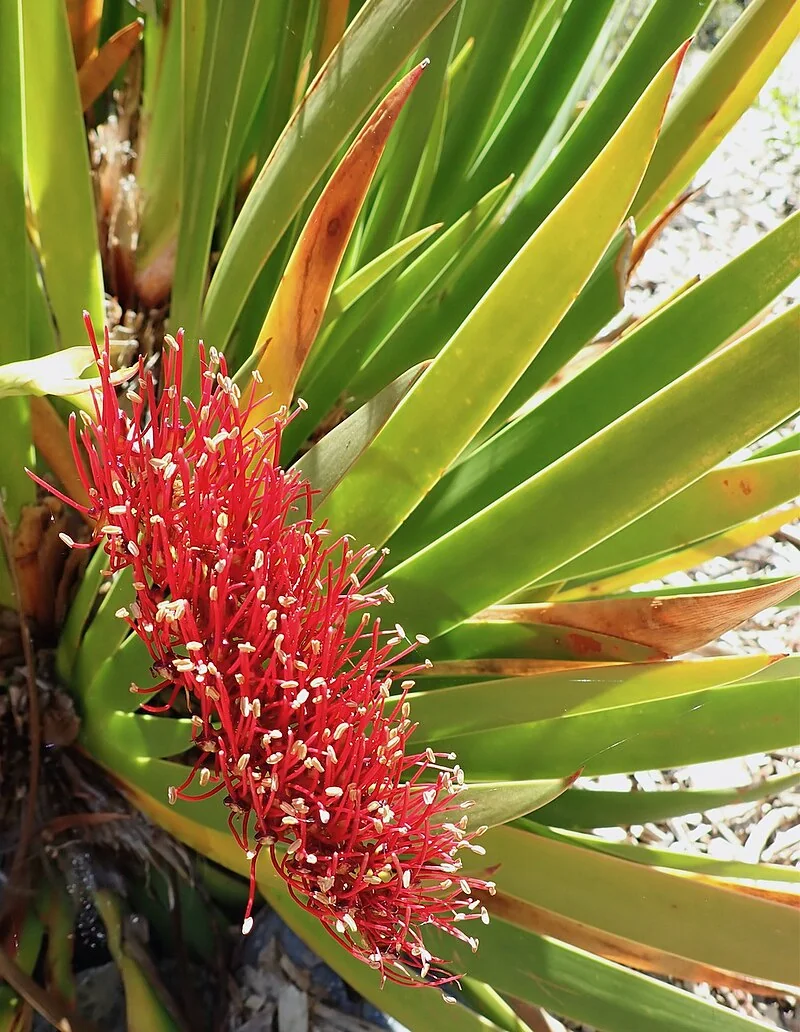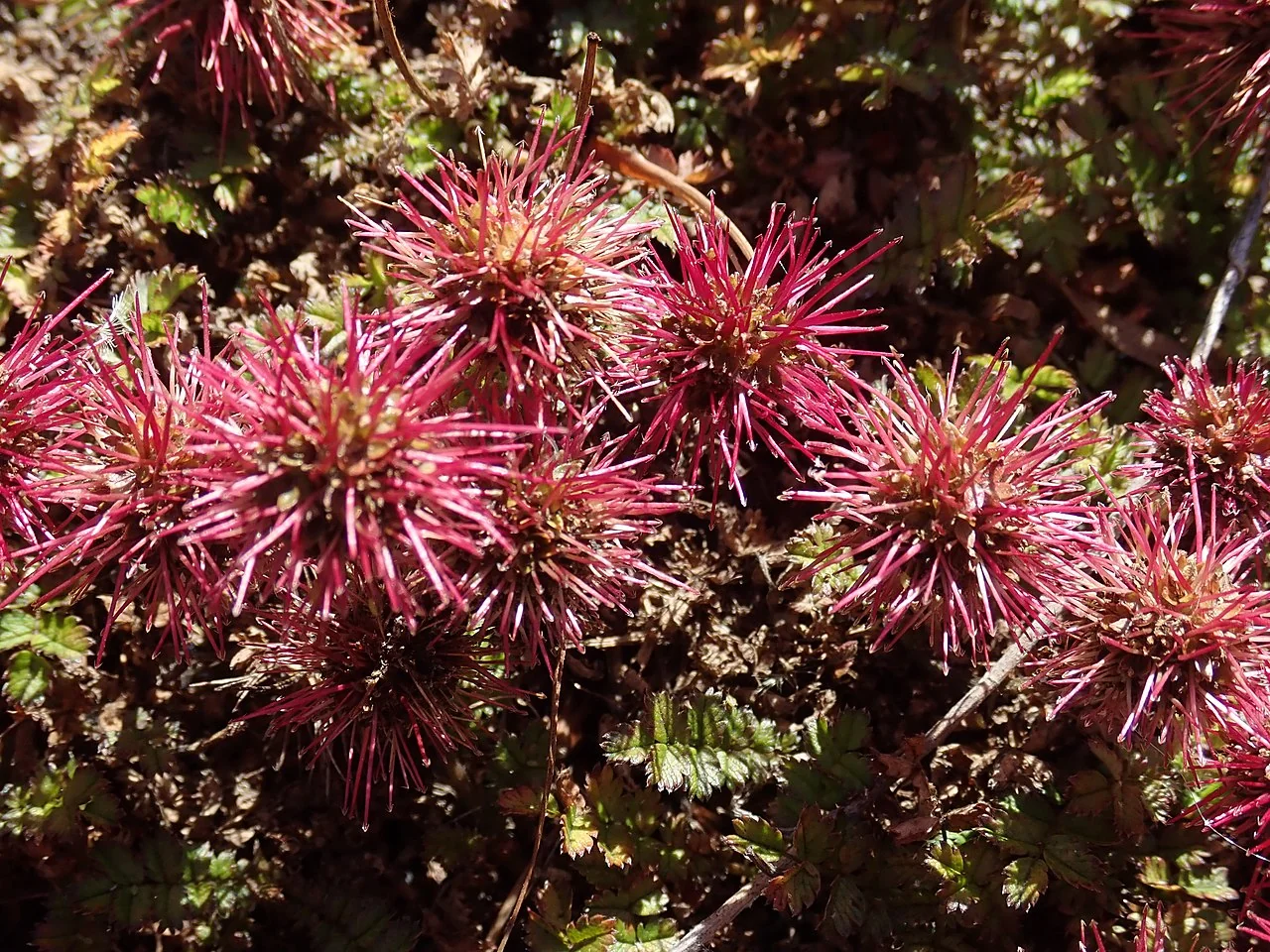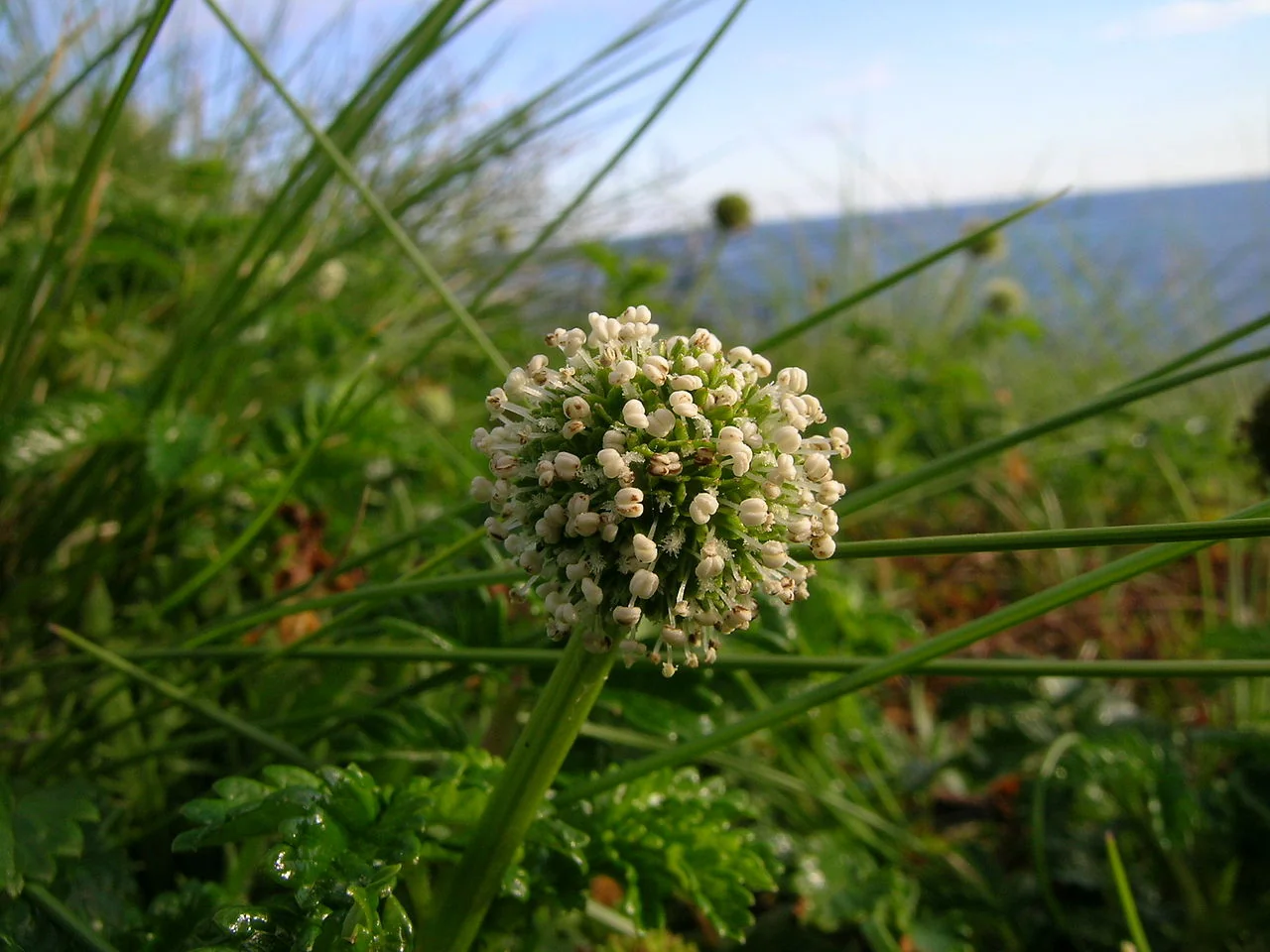
Poor Knights Lily
Xeronema callistemon
Introduction
Poor Knights Lily (scientific name: Xeronema callistemon ) is one of New Zealand's rarest and most spectacular native plants, producing extraordinary bright red bottlebrush-like flowers that are unlike anything else in the flora. This critically rare endemic is found only on the Poor Knights Islands and Taranga Island, making it one of our most precious botanical treasures. Its dramatic scarlet flower spikes and sword-like leaves create an unforgettable display in its cliff-top habitat. Explore more in the native plants index .

Plant Description
Botanical Features
Poor Knights Lily ( Xeronema callistemon ) is a herbaceous perennial plant endemic to the Poor Knights and Hen Islands off the northeast coast of New Zealand's North Island. It was discovered in 1924. It has sword-shaped, green-yellow leaves that can grow up to 3 feet long and 2 inches wide, forming flattened, iris-like fans. Mature clumps can reach up to 3 feet tall and spread up to 13 feet wide in ideal conditions, though typically up to 6 feet in cultivation. Sturdy, gently arching flower stalks, about 3 feet tall, emerge in late spring. These stalks bear dense, bottlebrush-like racemes of small, red flowers, typically 4-20 inches long, but can reach up to 45 cm. The prominent red stamens, tipped with orange pollen, contribute to the bottlebrush appearance. The genus name "Xeronema" means "dry thread," referring to the persistent upright filaments of the flowers, while "callistemon" means "beautiful stamens." This slow-growing plant can take 10-15 years to reach flowering maturity from seed. It naturally grows on exposed, sheer rock faces and rhyolite sea cliffs, sometimes as an epiphyte on trees like Metrosideros excelsa .
Quick Facts
Essential Information
| Scientific Name | Xeronema Callistemon |
|---|---|
| Height | Up to 1 m |
| Spread | Up to 1.5 m |
| Water Needs | Moderate; requires excellent drainage |
| Light | Full sun to partial shade |
| Frost Tolerance | Low; frost tender |
| Salt Tolerance | High |
| Growth Rate | Slow |
| Lifespan | Very long-lived |
Climate Best Suited to
As a native of the northern offshore islands, the Poor Knights Lily thrives in warm, frost-free, coastal climates. It is best suited to the northern parts of the North Island. In cooler areas, it must be grown in a container and moved to a protected location over winter.
Regional Suitability
| Whangārei | Ideal |
| Auckland | Ideal |
| Hamilton | Suitable |
| Rotorua | Suitable |
| Tauranga | Ideal |
| Gisborne | Ideal |
| New Plymouth | Ideal |
| Whanganui | Ideal |
| Palmerston North | Suitable |
| Napier | Ideal |
| Wellington | Ideal |
| Nelson | Ideal |
| Christchurch | Suitable |
| Dunedin | Suitable |
| Invercargill | Suitable |
| City | Climate Suitability |
|---|
Natural Habitat
Poor Knights Lily ( Xeronema callistemon ) is a herbaceous perennial plant endemic to the Poor Knights Islands and Hen (Taranga) Island, located off the northeast coast of New Zealand's North Island. It was discovered in 1924 and is considered a critically rare endemic.
Key Habitats Include:
- Exposed Rhyolite Sea Cliffs and Rocky Outcrops: It primarily inhabits exposed, sheer rhyolite sea cliffs and rocky outcrops, often around 1000 feet above sea level. This highlights its adaptation to harsh, exposed, and well-drained environments.
- Forests (Occasionally): Occasionally, it grows in forests on rubble or as an epiphyte on other trees, such as Metrosideros excelsa (pōhutukawa), showcasing some ecological flexibility.
Preferred Conditions:
- Warm, Salt-Laden Air: This plant thrives in warm, salt-laden air, indicating its preference for coastal, maritime conditions.
- Excellent Drainage: It requires ample water but demands constantly free-draining substrates with minimal competition, reflecting its natural habitat on rocky cliffs.
- Full Sun: It performs best in full sun to partial shade.
The unique and restricted natural habitat of Xeronema callistemon underscores its ecological importance and its status as a precious botanical treasure within New Zealand's unique island flora.
Plant Conservation
Xeronema callistemon , commonly known as the Poor Knights Lily, is a critically rare flowering plant endemic to the Poor Knights Islands and Taranga Island in the north of New Zealand. While it was listed as "vulnerable" in the 1997 IUCN Red List of Plants, it is no longer listed in the IUCN Red List of Threatened Species as of October 2010. However, the NZPCN notes its conservation status is due to its endemic nature, being confined to two small island archipelagos.
The islands where it naturally grows are protected by the New Zealand Government as nature reserves with limited access, which aids in its protection. Conservation efforts focus on protecting its natural habitat on rhyolite sea cliffs and rocky outcrops, and sometimes in forests, ensuring the survival of this unique botanical treasure.
Growing Requirements
Soil Requirements
Poor Knights Lily ( Xeronema callistemon ) thrives in extremely well-draining, rocky or sandy soil. Understanding its natural habitat in cliff faces and rocky areas on offshore islands helps guide successful cultivation.
- Natural habitat: cliff faces and rocky areas on offshore islands
- Soil preference: extremely well-draining, rocky or sandy soil
- Good drainage important for healthy root development
- Benefits from organic matter incorporation where appropriate
- Avoid conditions that differ significantly from natural habitat
Light Requirements
Poor Knights Lily ( Xeronema callistemon ) performs best in full sun. This reflects its natural growing conditions and ensures optimal growth and health.
- Preferred light conditions: full sun
- Plant in position that mimics natural habitat
- Consider seasonal light changes in garden placement
- Protect from extreme conditions if necessary
Water Requirements
Poor Knights Lily ( Xeronema callistemon ) has very low, extremely drought-tolerant. Understanding these needs ensures successful establishment and long-term health.
- Water requirements: very low, extremely drought-tolerant
- Regular watering important during establishment
- Adjust watering to match natural habitat conditions
- Monitor for signs of water stress
- Mulching can help maintain appropriate soil moisture
Planting Guide
Getting Placement and Substrate Right
In nature Poor Knights Lily ( Xeronema callistemon ) grows as a cliff specialist on shallow, gritty pockets of soil over hard volcanic rock and occasionally as an epiphyte in coastal trees. Successful cultivation comes from mimicking this: warmth, abundant light, excellent drainage, and a lean, stony medium that never stays wet around the crown.
- Exposure: Full sun with reflected heat is ideal; bright light is essential for flowering.
- Frost: Best in frost-free sites; brief light frosts may damage foliage. Provide winter protection in marginal climates.
- Drainage: Critical. Use raised beds, rock crevices, or large free-draining containers.
- Soil mix (pots/raised beds): 50-70% coarse pumice/scoria or gravel, 20-30% coarse sand, 10-20% fibrous organic (fine bark) - airy and lean.
- pH: Neutral to slightly acidic is fine; avoid heavy clay and rich, water-holding mixes.
How to Plant
- Prepare the pocket: Create a sloping, free-draining planting pocket that sheds water away from the crown.
- Set the plant high: Position the base of the fan just above the surrounding surface; never bury the neck.
- Backfill lightly: Firm with the gritty mix; top with a thin gravel mulch to keep the crown dry.
- Water-in once: Water thoroughly after planting, then let the mix dry before the next irrigation.
- Acclimate to sun: If coming from shade, harden off over 1-2 weeks to avoid scorch.
Container Culture Tips
- Container: Wide, shallow terracotta bowls or troughs promote rapid drainage and warm roots.
- Repotting: Infrequent; they dislike root disturbance. Step up only when clearly pot-bound.
- Watering: In warm growth, water deeply but infrequently; keep on the dry side in cool weather. Avoid water sitting in leaf axils.
- Feeding: Light hand with a low-phosphorus, slow-release fertiliser in spring; overfeeding encourages rot and soft growth.
Aftercare
Flowering typically follows a warm, bright season. Keep crowns airy, remove spent flower spikes at the base after display, and protect from prolonged winter wet. In cooler regions, overwinter under cover with maximum light and minimal watering.
Ecological Role
Environmental Benefits
- Habitat function: Binds debris on cliffs and ledges, adding structure in sparsely vegetated rock systems.
- Mutualists: Provides concentrated nectar resources for birds during late spring and early summer.
- Stress tolerance: Handles high light, heat, and salt spray when drainage is extreme; fails in stagnant, wet soils.
- Recruitment: Seedlings establish in fissures with minimal competition; periodic dry spells reduce damping-off and favour survival.
Uses and Significance
A Horticultural Treasure
- Specimen Plant: Its unique form and spectacular flowers make it a prized specimen plant for collectors and enthusiasts.
- Container Growing: It is an excellent container plant, which allows its specific soil and drainage needs to be met easily. This is the best way to grow it in cooler climates.
- Coastal Gardens: Its tolerance of salt spray makes it a great choice for frost-free coastal gardens.
- Ecological Interest: A striking example of New Zealand's unique island flora. The flowers are bird-pollinated.
Cultural Significance
Cultural Importance
Poor Knights Lily ( Xeronema callistemon ), also known as the Poor Knights Lily or Raupō Taranga, holds significant cultural importance, particularly in New Zealand. The plant is recognized in Māori tradition, where it is known as "raupō taranga." It is celebrated as one of New Zealand's most spectacular and iconic native plants, considered a true botanical treasure due to its rarity and distinctive appearance. Its unique form and striking flowers make it a prized specimen for collectors and enthusiasts. The plant has also gained popularity in gardens, especially subtropical gardens in Auckland, for its vibrant, sword-like foliage and extraordinary red flowers. Endemic to the Poor Knights Islands and Taranga Island, its status as a vulnerable species underscores its importance within New Zealand's unique island flora and highlights ongoing conservation efforts. There has been a suggestion that Whangārei, a city near its natural habitat, should adopt the Xeronema callistemon as an icon for street plantings.
Landscaping Ideas
Design Uses
- Specimen focal point: Platform a mature clump in a raised, stony bed or crevice garden where the sideways flower spikes can be appreciated.
- Coastal and courtyard schemes: Excellent in frost-free, maritime settings with reflected heat from paving or walls.
- Containers: Wide, shallow pots on sunny terraces allow precise control of drainage and are ideal outside its natural climate.
Companions
- Libertia , Astelia , and Leptospermum for contrasting textures in dry, sunny beds.
- Metrosideros excelsa and low-growing Pseudopanax in coastal schemes; keep competition light and the crown open.
Practical Tips
- Prioritise drainage over fertility; a gravel mulch keeps the neck dry and warm.
- Heat and strong light encourage flowering; avoid shade from fast-growing neighbours.
- In areas with winter rain and cold, move container plants under cover to prevent crown rot.
Seasonal Care Calendar
Spring
Spring is an active growth period for Poor Knights Lily ( Xeronema callistemon ). New growth emerges and this is an ideal time for planting new specimens. Monitor soil moisture as temperatures warm and growth accelerates.
- Active growth period with new development
- Ideal time for planting new specimens
- Monitor soil moisture as growth increases
- Apply organic mulch if needed
Summer
Summer is typically the main growing season for Poor Knights Lily ( Xeronema callistemon ). Spring flowering occurs during this period. Ensure adequate watering during hot, dry periods according to the plant's specific needs.
- Peak growing season with active development
- Monitor watering needs during hot weather
- Flowering period: spring
- Established plants show good heat tolerance with appropriate care
Autumn
During autumn, Poor Knights Lily ( Xeronema callistemon ) begins to slow its growth as temperatures cool. This is another good time for planting as conditions become more favorable. Reduce watering frequency but maintain appropriate soil moisture.
- Growth slows as temperatures moderate
- Good time for planting new specimens
- Reduce watering frequency gradually
- Maintain appropriate soil moisture for species
Winter
Winter is typically a dormant period for Poor Knights Lily ( Xeronema callistemon ), with minimal growth activity. Reduce watering but ensure plants don't completely dry out if they require consistent moisture. Most New Zealand natives are cold-hardy.
- Dormant period with minimal growth activity
- Adjust watering to seasonal needs
- Generally cold-hardy in most New Zealand climates
- Minimal winter protection required for most natives
When to Prune and How Much
Overview
Poor Knights Lily ( Xeronema callistemon ) generally requires minimal pruning to maintain its natural form and health. Most maintenance involves removing dead or damaged growth and light shaping if needed.
- Remove dead, damaged, or diseased growth as needed
- Light pruning to maintain shape if desired
- Prune after flowering if applicable
- Avoid heavy pruning which can stress the plant
- Use clean, sharp tools to prevent disease
- Most natives maintain good form without regular pruning
Always use clean, sharp tools when pruning to minimize disease risk. Native plants typically maintain their natural form well and often require less intervention than exotic species.
How to Grow Poor Knights Lily
The Poor Knights Lily is a truly spectacular and unique plant, but it requires very specific growing conditions to thrive. Native to the Poor Knights Islands, it is accustomed to a warm, frost-free, coastal climate with excellent drainage. It is a slow-growing plant, and patience is key to its successful cultivation. Due to its rarity and specific needs, it is often grown by enthusiasts in containers, which allows for precise control over its environment.
From Cuttings
Propagating Poor Knights Lily from cuttings can be challenging but is a rewarding method for those seeking to replicate a specific plant. Take semi-hardwood cuttings from healthy, non-flowering shoots in late spring or early summer. Cuttings should be about 4-6 inches long. Remove the lower leaves and dip the cut end in a rooting hormone. Plant the cuttings in a very well-draining, gritty mix, such as a blend of perlite, coarse sand, and a small amount of peat or coco coir. Maintain high humidity around the cuttings, perhaps by placing them under a plastic dome or in a propagator, and provide bottom heat to encourage root development. Keep the medium consistently moist but never waterlogged. Rooting can take several months, and success rates can vary.
From Seed
Growing Poor Knights Lily from seed is a long-term endeavor, as plants can take 10-15 years to reach flowering maturity. Fresh seeds are essential for good germination rates. Sow the seeds in a tray of very well-draining seed-raising mix, lightly covering them with a thin layer of grit. The seeds may benefit from a period of cold stratification, so placing the tray outdoors in a sheltered spot over winter can be beneficial. Maintain consistent moisture in the seed tray, ensuring it never dries out completely but also avoids waterlogging. Germination can be erratic and prolonged. Once seedlings are large enough to handle, typically after developing their first true leaves, they can be pricked out and potted into individual containers. It is crucial to disturb the roots as little as possible during transplanting.
Division
For established, multi-crowned plants, division can be the easiest method of propagation. This is best done in spring when the plant is actively growing. Carefully lift the entire clump and gently separate it into smaller sections, ensuring each division has a healthy portion of roots and at least one growing point. Replant the divisions immediately into well-draining soil or pots, and water thoroughly until established. This method is generally more successful than seed propagation for mature plants.
Pests and Diseases
Root Rot Is the Enemy
The single biggest issue is root rot caused by poor drainage or overwatering. Otherwise, it is generally pest-free, though mealybugs can sometimes be a problem on container-grown plants.
Bonus Tip
The Poor Knights Lily ( Xeronema callistemon ) is not only visually stunning but also has a fascinating reproductive strategy. Its flower stalks initially grow vertically before making a curious sideways turn, possibly serving as a landing perch for birds or butterflies, which are its primary pollinators. This unique adaptation highlights the intricate relationship between the plant and its island ecosystem. Additionally, each leaf has a mysterious curved notch at its base where it touches the next leaf, a feature that adds to the plant's distinctive character.







